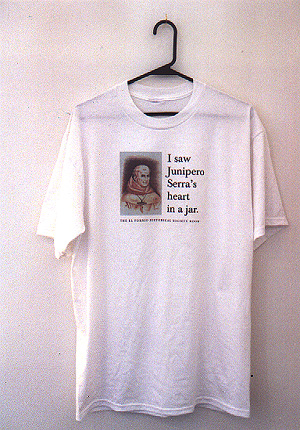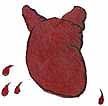
1.
August 28, 1784:
Serra Dies and His Heart is Cut Out
from The Reeducation
of a Turd Peddler
by John Henry Peabody, based on his
interviews of Fornay storytellers
WHEREIN JUNIPERO SERRA DIES AND HIS HEART IS REMOVED BY A FORNAY INDIAN
AGENT.
*
“Tai Fun did not go through the sternum. He
went under the ribs on the left side of Serra’s body, cutting
the first layer quickly, then continued up to wrap his hand around
the heart, index finger and thumb tight on the top ventricle group
which he clipped with the chert knife only by feel, using his right
hand.”
THE BLACK DOGS OF EL FORNIO
are a mix between an indigenous hunting dog used by the Fornay Indians
and a Scottish Terrier-Australian Shepard mix left behind by a trading
vessel in 1806.
Captain Michael McCrea, an avid dog lover, was skipper of
the Holly Hag, and his logs show that during a visit to Mission
El Fornio in the summer of 1806, six of his favorite pups had run
off ship and couldn’t be relocated by the time Captain McCrea reembarked.
Exhibiting keen wit and loyalty, the Black
Dogs are famous as hunting and herding animals. Modern day Fornay
breed the creatures. “Duff,” the dog in John Ford’s production
of Mark Twain’s The Trails of El Fornio
(1952), with Robert Mitchum and Ava Gardner, was an El Fornio Black
Dog.
In 2001, the United States Post Office issued a stamp commemorating
the Black Dogs of El Fornio, paying homage to this distinct West Coast
breed. The American Kennel Club recognized the Black Dog in 1962.
The day Junipero Serra’s heart was removed from his
body by a Fornay agent at Mission Carmel, a breed of the dog that would
go on to become a Black Dog was present. The date was August 28, 1784.
The United States Congress had just ratified the Treaty of Paris with
the English, putting an end to the American Revolutionary War; Ben Franklin
took the opportunity to convince the French to adopt daylight savings
as a winter option (they didn’t); the first bales of American cotton
were arriving in Britain; in Japan, three hundred thousand people died
in a famine; huge swarms of locusts were dominating South Africa; and
Samuel Johnson, one of England’s great literary dictators, was
sixteen weeks away from his final lexicographical breath.
Such is August 28, 1784.
The person who removed Father Serra’s heart, Sumx Tai
Fun, arrived with the dog, Mup Gao, to do his business two days before
Serra passed—word had been sent that the old friar was on his last
healthy leg.
Tai Fun’s blade was made of brown chert—later
to be called Franciscan chert—rich as chocolate, dense and sharp
enough to clean a large fish. He had to act quickly, his Monterey Indian
contacts looking out, watching Mup Gao playfully chase his tail in the
dust during the endeavor.
Tai Fun did not go through the sternum. He went under the
ribs on the left side of Serra’s body, cutting the first layer
quickly, then continued up to wrap his hand around the heart, index
finger and thumb tight on the top ventricle group which he clipped with
the chert knife only by feel, using his right hand.
The heart came out like an oyster sliding off a plate of
Mother of Pearl, shucked into Tai Fun’s deerskin apron. He then
skipped back out the window into the woods. There Tai Fun met up with
the mission clay jar—marked at the kiln—filled with padre
brandy. Then the heart was washed with creek water and slid into the
jar, its lid of oak whorl pushed tightly.
As Tai Fun and Mup Gao ambled through the woods, they made
there way back to a hearthed camp in the hills where Tai Fun’s
horse was waiting.
The jar was reopened. A mixture of asphaltum and pine tree pitch was
spread on the lid which caused it to stick tightly in the jar. Melted
paraffin from the chapel candles was used for the final seal.
Tai Fun, with the dog in front of him on the saddle, galloped
southward. They came to a Salinan Indian encampment where they spent
the night. In the morning they continue onward, Serra’s heart banging
back and forth against the sides of the pot.
Close to Mission San Luis Obispo, Tai Fun and the dog stopped
for the night. They were both tired. Tai Fun made camp under an oak
tree, removing the saddle and supplies he had packed on the horse. He
could hear an owl in the branches above them.
“If the owl lets us stay,” he said to Mup Gao,
“We’ll have good luck.”
Tai Fun led the horse down to the creek where it drank.
Then he returned to the oak tree where the animal ate dried savannah
grass. Tai Fun put the jar at the head of his blanket so that he might
rest against it when night fell. He began a fire.
In the chaparral, animals were moving about with the wind. The owl swept
out of the tree and into the twilight. Mup Gao looked at Tai Fun and
began to shake, wetting himself.
“What are you doing, dog?” Tai Fun asked. He looked
about and opened his senses to the trees and sky and spirits in the
area. Ahead a rustling from the brush came through and Tai Fun had only
a moment to consider the size of the animal before it struck.
The Spanish called the area La Cañada de los Osos. They had been
impressed by the amount of ground damage the grizzly bears had done
while scouring for tule roots.
In 1772,
famished and near desperation, the Spanish had sent a hunting party
to the “Valley of the Bears” where they stayed three months
killing and preserving bear meat. Nine thousand pounds of jerked and
salted bear meat was packed up and sent to area missions.
While there are no grizzlies there today, they lived like
voles at the time, cavorting and foraging with a population density
difficult to imagine in today’s terms. Tai Fun, and even the dog
Mup Gao, knew that bears were lurking. Perhaps they should have known
when the owl fled the oak tree. The bear owned them and, after dispatching
the dog quickly, dined on Tai Fun and the horse for two days. The jar,
on the other hand, confused the bear with its lid of wax, pitch and
acrid brandy. It lay for three days before being happened upon.
NEXT
2.
August 30, 1784
Wherein A Search Party Looks for Tai
Fun,
Mup Gao and the Heart

|

